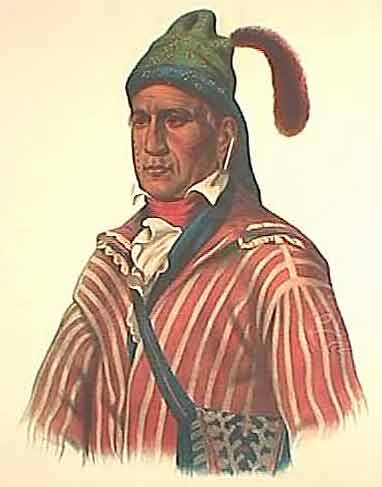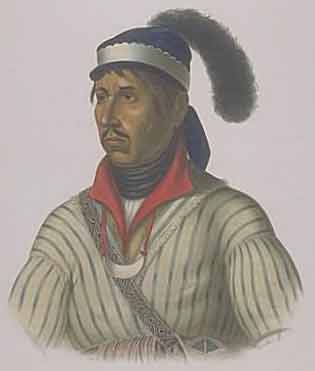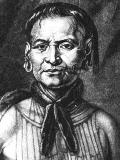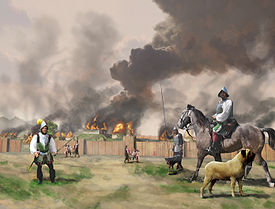To view this page in another language, please click here:
Muskogee
Creek Literature
"Experience is the wisest teacher, and history does not furnish
an example of a forced civilization being permanent and real."
Pleasant Porter, 1973
The Muscogee are descendants of the Mississippian culture peoples, who built earthwork mounds at their regional chiefdoms located throughout the Mississippi River valley and its tributaries. The historian Walter Williams and others believe the early Spanish explorers encountered ancestors of the Muscogee when they visited Mississippian-culture chiefdoms in the Southeast in the mid-16th century.
The Muscogee were the first Native Americans considered to be "civilized" under George Washington's civilization plan. In the 19th century, the Muscogee were known as one of the "Five Civilized Tribes", because they had integrated numerous cultural and technological practices of their more recent European American neighbors. Influenced by their prophetic interpretations of the 1811 comet and earthquake, the Upper Towns of the Muscogee, supported by the Shawnee leader Tecumseh, began to resist European-American encroachment. Internal divisions with the Lower Towns led to the Red Stick War (Creek War, 1813–1814), begun as a civil war within the Muscogee Nation, it enmeshed them in the War of 1812 against the United States.
During the Indian Removal of the 1830s, most of the Muscogee Confederacy were forcibly relocated to Indian Territory. The Muscogee (Creek) Nation, Alabama-Quassarte Tribal Town, Kialegee Tribal Town, and Thlopthlocco Tribal Town, all based in Oklahoma, are federally recognized, as are the Poarch Band of Creek Indians of Alabama, the Coushatta Tribe of Louisiana, and the Alabama-Coushatta Tribe of Texas.
Creek Leaders
Apauly Tustennugge
Ledagie
M'Intosh
Chief McIntosh
Mistippee
Nahetluchopie
Oche Finceco
(Charles Cornell)
Opothle Yoholo
"Ho-Po-Eth-Le-Yo-Ho-Lo."
Paddy Carr
Selocta

Menawa
The Great
Warrior
Chief of the Upper Muskokee (Creek)
Menawa, also called Hothlepoya, was war chief of the Upper Towns Creek. Born in the 1780s, he had earned the title "Crazy War Hunter" for his exploits in battle, including his bravery at the battle of Horseshoe Bend in 1814. He fervently hated the white man and refused to join Chief William McIntosh's conciliatory efforts. After watching his tribe cede its land piecemeal for a decade, culminating in a treaty which forced the Creek to relocate, Menawa led a raiding party which killed McIntosh in 1825. The act did not stop white incursion onto Creek land, however, and Menawa himself was forced to accede to white territorial demands the following year in a treaty concluded with Secretary of War James Barbour.

In the early 1700's, the Creek tribe was the most cooperative with the British settlers in the Georgia Territory. With the active assistance of Creek leaders like Tomochichi (shown here with his nephew), Georgia was rapidly and peacefully settled by British colonists. In return for massive land grants, the Creek were accorded privileges, such as protection under the British law and liberal trading rights. Tomochichi was praised for his peacemaking efforts, and in 1734 was rewarded with a trip to England with his family. He remained a friend to the British for the rest of his life
The Muskokee (Creek) became a combined Muskokee (Creek) Confederacy of most nations of the southeastern states who thrived as early as de Soto's time in the early 1500s. Two strong geographical groups, the Upper Muskokee (Creek) and Lower Muskokee (Creek), each possessed many interesting nations that gradually increased in size and spread throughout Georgia, Alabama, Florida, Louisiana, Mississippi, and the Carolinas. As white people spread southward along coastal areas, Muskokee (Creek) were driven to the interior areas, especially along the Chattahoochee and Ocmulgee rivers. In the 1700s and 1800s bands of the Muskokee (Creek) nation migrated northward, infiltrating nations of the central, plains, and southwestern areas.

Stories
How Day and Night Were Divided
How Rabbit Brought Fire to the People
How Rabbit Fooled Alligator
How Rabbit Fooled Wolf
Story of the Bat
Walnut Cracker
Creek Indian Bibliography
Creek Language Archive
Creek images
North
Georgia Creek History
![]() Return to Indigenous Peoples' Literature
Return to Indigenous Peoples' Literature
Compiled by: Glenn Welker
ghwelker@gmx.com
This page last updated 07/16/2016 05:54:19
This site has been accessed 10,000,000 times since February 8, 1996.


